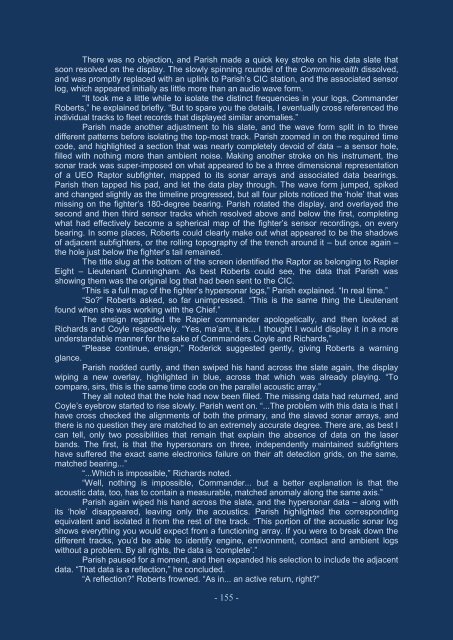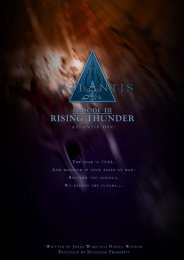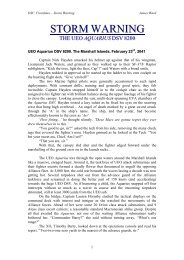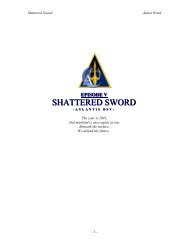CROSSFIRE - Atlantis DSV - New Cape Quest
CROSSFIRE - Atlantis DSV - New Cape Quest
CROSSFIRE - Atlantis DSV - New Cape Quest
Create successful ePaper yourself
Turn your PDF publications into a flip-book with our unique Google optimized e-Paper software.
There was no objection, and Parish made a quick key stroke on his data slate that<br />
soon resolved on the display. The slowly spinning roundel of the Commonwealth dissolved,<br />
and was promptly replaced with an uplink to Parish‟s CIC station, and the associated sensor<br />
log, which appeared initially as little more than an audio wave form.<br />
“It took me a little while to isolate the distinct frequencies in your logs, Commander<br />
Roberts,” he explained briefly. “But to spare you the details, I eventually cross referenced the<br />
individual tracks to fleet records that displayed similar anomalies.”<br />
Parish made another adjustment to his slate, and the wave form split in to three<br />
different patterns before isolating the top-most track. Parish zoomed in on the required time<br />
code, and highlighted a section that was nearly completely devoid of data – a sensor hole,<br />
filled with nothing more than ambient noise. Making another stroke on his instrument, the<br />
sonar track was super-imposed on what appeared to be a three dimensional representation<br />
of a UEO Raptor subfighter, mapped to its sonar arrays and associated data bearings.<br />
Parish then tapped his pad, and let the data play through. The wave form jumped, spiked<br />
and changed slightly as the timeline progressed, but all four pilots noticed the „hole‟ that was<br />
missing on the fighter‟s 180-degree bearing. Parish rotated the display, and overlayed the<br />
second and then third sensor tracks which resolved above and below the first, completing<br />
what had effectively become a spherical map of the fighter‟s sensor recordings, on every<br />
bearing. In some places, Roberts could clearly make out what appeared to be the shadows<br />
of adjacent subfighters, or the rolling topography of the trench around it – but once again –<br />
the hole just below the fighter‟s tail remained.<br />
The title slug at the bottom of the screen identified the Raptor as belonging to Rapier<br />
Eight – Lieutenant Cunningham. As best Roberts could see, the data that Parish was<br />
showing them was the original log that had been sent to the CIC.<br />
“This is a full map of the fighter‟s hypersonar logs,” Parish explained. “In real time.”<br />
“So?” Roberts asked, so far unimpressed. “This is the same thing the Lieutenant<br />
found when she was working with the Chief.”<br />
The ensign regarded the Rapier commander apologetically, and then looked at<br />
Richards and Coyle respectively. “Yes, ma‟am, it is... I thought I would display it in a more<br />
understandable manner for the sake of Commanders Coyle and Richards,”<br />
“Please continue, ensign,” Roderick suggested gently, giving Roberts a warning<br />
glance.<br />
Parish nodded curtly, and then swiped his hand across the slate again, the display<br />
wiping a new overlay, highlighted in blue, across that which was already playing. “To<br />
compare, sirs, this is the same time code on the parallel acoustic array.”<br />
They all noted that the hole had now been filled. The missing data had returned, and<br />
Coyle‟s eyebrow started to rise slowly. Parish went on. “...The problem with this data is that I<br />
have cross checked the alignments of both the primary, and the slaved sonar arrays, and<br />
there is no question they are matched to an extremely accurate degree. There are, as best I<br />
can tell, only two possibilities that remain that explain the absence of data on the laser<br />
bands. The first, is that the hypersonars on three, independently maintained subfighters<br />
have suffered the exact same electronics failure on their aft detection grids, on the same,<br />
matched bearing...”<br />
“...Which is impossible,” Richards noted.<br />
“Well, nothing is impossible, Commander... but a better explanation is that the<br />
acoustic data, too, has to contain a measurable, matched anomaly along the same axis.”<br />
Parish again wiped his hand across the slate, and the hypersonar data – along with<br />
its „hole‟ disappeared, leaving only the acoustics. Parish highlighted the corresponding<br />
equivalent and isolated it from the rest of the track. “This portion of the acoustic sonar log<br />
shows everything you would expect from a functioning array. If you were to break down the<br />
different tracks, you‟d be able to identify engine, enrivonment, contact and ambient logs<br />
without a problem. By all rights, the data is „complete‟.”<br />
Parish paused for a moment, and then expanded his selection to include the adjacent<br />
data. “That data is a reflection,” he concluded.<br />
“A reflection?” Roberts frowned. “As in... an active return, right?”<br />
- 155 -





